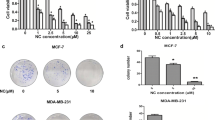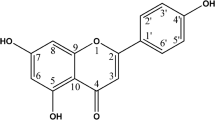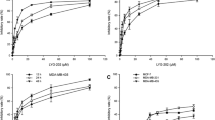Abstract
Recent studies both in vitro and in vivo of G. procumbens exhibits chemopreventive properties for tumor inhibition on several types of cancer. Our study was carried out to observe the anticancer property of ethyl acetate fraction of G. procumbens leaves (FEG) on breast cancer cells as well as the co-chemotherapeutic potential, and to investigate its molecular mechanisms. 3-(4,5-dimethyl-thiazol-2-yl)-2,5-diphenyltetrazolium bromide (MTT) assay was used to measure the growth inhibitory effect of FEG, doxorubicin (DOX), and 5-fluorouracil (5-FU) and their combination. Flowcytometry, 4′,6-diamidino-2-phenylindole (DAPI) staining, and immunobloting were used to explore the mechanism of cell cycle arrest and apoptosis. FEG inhibited cell proliferation, induced G1 phase arrest and apoptosis. The inhibitory effect of FEG was enhanced when combined with Dox and 5-FU. The apoptosis induction was related to the increase of c-PARP expression after combination treatment of FEG and Dox or 5-FU on MCF-7 cells. However, treatment of DOX, 5-FU, and FEG on T47D cells, resulting no significance DNA fragmentation and nuclei condensation evidance. Only combination treatment of 5-FU + FEG showed c-PARP expression in T47D cells. In T47D cells, The FEG treatment also caused the decrease of microtubule expression as shown by Western blotting assay. The decreasing level of microtubul expression might be caused by protein aggregation, as shown by immunostaning using α-tubulin antibody. All these results suggest that FEG potentiates the DOX and 5-FU efficacy on MCF-7 and T47D cells. FEG induces T47D cell death through different mechanism than MCF-7 that proposed to be mitotic catastrophe. The FEG may have specific targeted on microtubule integrity modulation leading to the cell cycle arrest and proliferation inhibition. Further FEG could be developed as a co-chemotherapeutic agent for reducing side effect and have specific molecular target for breast cancer.









Similar content being viewed by others
References
Agustina D, Wasito, Haryana SM, Supatinah A (2006) Anticarcinogenesis effect of Gynura procumbens (Lour) Merr on tongue carcinogenesis in 4NQO-induced rat. Dent J 39:126–132
Castedo M, Pefettini JL, Roumier T, Andreau K, Medema R, dan Kroemer G (2004) Cell death by mitotic catastrophe: a molecular definition. Oncogene 23:2825–2837
Dannenberg JH, David G, Zhong S, van der Torre J, Wong WH, Depinho RA (2005) mSin3A co repressor regulates diverse transcriptional networks governing normal and neoplastic growth and survival. Gene & Dev 19:1581–1595
Devarajan E, Sahin AA, Chen JS, Krishnamurthy RR, Aggarwal N, Brun AM, Zhang F, Sharma D, Yang XH, Tora AD, Mehta K (2002) Down-regulation of caspase 3 in breast cancer: a possible mechanism for chemo resistance. Oncogene 21:8843–8851
Faneyte IF, Kristel PMP, Maliepaard M, Scheffer GL, Scheper RJ, Schellens JHM, van de Vijver (2002) Expression of the breast cancer resistance protein in breast cancer. Clin Cancer Res 8:1068–1074
Garcia M, Jemal A, Ward EM, Center MM, Hao Y, Siegel RL, Thun MJ (2007) Global cancer facts & figures 2007. American Cancer Society, Atlanta
Harris G, Schaefer L (2009) The microtubule-targeting agent T0070907 induces proteasomal degradation of tubulin. Biochem Biophys Res Comm 388:345–349
Iskander MN, Song Y, Coupar IM, Jiratchariyakul W (2002) Antiinflamatory screening of medicinal plant G. Procumbens. Plant Foods Hum Nutr 57:233–244
Jackson SJT, Venema RC (2006) Quercetin inhibits eNOS, microtubule polimerization, and mitotic progression in bovine aortic endothelial cells. J Nutr 136:1178–1184
Jenie RI, Meiyanto E, dan Murwanti R (2006) Antiangiogenic effect of sambung nyawa leaves (Gynura procumbens (Lour.) Merr.) etanolic extract on chick embryo chorioallantoic membrane (CAM). Indones J Pharm 17(1):50–55
Jenie RI, dan Meiyanto E (2007) Co-chemotherapy of sambung nyawa (Gynura procumbens (Lour.) Merr.) leaves ethanolic extract and Doxorubicin on breast cancer cell. Indones J Pharm 18(2):81–87
Jonathan EC, Bernhard EJ, McKenna WG (1999) How does radiation kill cells? Curr Opin Chem Biol 3:77–83
Kim M, Lee HJ, Wiryowidagdo S, Kim HK (2006) Antihypertensive effects of G. Procumbens extract in spontaneously hypertensive Rats. J Med Food 9(4):587–590
Lai A, Kennedy BK, Barbie DA, Bertos NR, Yang XJ, Theberge MC, Tsai SC, Seto E, Zhang Y, Kusmichev A (2001) RBP1 recruits the mSIN3-histone deacetylase complex to the pocket of retinoblastoma tumor supressoe family protein found in limited discrete regions of the nucleus at growth arrest. Mol Cell Biol 8:2918–2932
Lee HJ, Lee BC, Chung JH, Wiryowidagdo S, Chun W, Kim SS, Kim H, Choe M (2007) Inhibitory effects of aqueous extract of Gynura procumbens on human mesangial cell proliferation. Korean J Physiol Pharmacol 11:145–148
Meiyanto E, Septisetyani EP (2005) Antiproliferative and apoptotic effect of fenolic fraction of ethanolic extract of Gynura procumbens (Lour.) Merr. AGAINST HeLa CELLS. Artocarpus 5(2):74–80
Meiyanto E, Susilowati S, Tasminatun S, Murwanti R, dan Sugiyanto (2007) Chemopreventive effect of ethanolic extract of Gynura procumbens (Lour), Merr on the carcinogenesis of Rat breast cancer development. Indones J Pharm 18(3):154–161
Mi L, Xiao Z, Hood BL, Dakshanamurthy S, Wang X, Govind S, Conrads TP, Veenstra TD, Chung FL (2008) Covalent binding to tubulin by isothiocyanates, a mechanism of cell growth arrest and apoptosis. J Biol Chem 283(32):22136–22146
Mi L, Gan N, Cheema A, Dakshanamurthy S, Wang X, Yang DCH, Chung FL (2009) Cancer preventive isothiocyanates induce selective degradation of cellular α-and β-tubulins by proteasome. J Biol Chem 284(25):17039–17051
Mi L, Gan N, Chung FL (2010) Isothiocyanates inhibit proteasome activity and proliferation of multiple myeloma cells. Carcinogenesis 32(2):216–223
Murphy M, Ahn J, Walker KK, Hoffman WH, Evans RM, Levine AJ, George DL (1999) Transcriptional represorion by wild-type p53 utilies histone deacetylases, mediated by interaction with mSin3a. Gene & Dev 13:2490–2501
Nogales E (2001) Structural insight into microtubule function. Annu Rev Biophys Biomol Struct 30:397–420
Onuki R, Kawasaki H, Baba T, dan Taira K (2003) Analysis of a mitochondrial apoptotic pathway using Bid-targeted ribozymes in human MCF7 cells in the absence of a caspase-3-dependent pathway. Antisense Nucleic Acid Drug Dev 13(2):75–82
Perry LM (1980) Medicinal plants of east and southeast Asia: attributed properties and uses. The MIT press, USA, p 94
Prunet C, Lemaire-Ewing S, Ménétrier F, Néel D, dan Lizard G (2005) Activation of caspase-3-dependent and -independent pathways during 7-ketocholesterol- and 7β-hydroxycholesterol-induced cell death: a morphological and biochemical study. J Biochem Mol Toxicol 19(5):311–326
Ricci MS, Zong WX (2006) Chemotherapeutic approaches for targeting cell death pathways. Oncoligist 11:342–357
Rosidah, Yam MF, Sadikun A, Asmawi MZ (2008) Antioxidant potential of Gynura procumbens. Pharmaceutical Biol 46:616–625
Rosidah, Yam MF, Sadikun A, Ahmad M, Akowuah GA, Asmawi MZ (2009) Toxicology evaluation of standardized methanol extract of Gynura procumbens. J Ethnophar 123(2):244–249
Sadikun A, Idus A, Ismail N (1996) Sterol and sterol glycosides from the leaves of Gynura procumbens. Nat Prod Sci 19–23
Schaefer KL, Takahashi H, Morales VM, Harris G, Barton S, Osawa E, Nakajima A, Saubermann LJ (2006) PPARγ inhibitors reduce tubulin protein levels by a PPARγ, PPA, Rδ and proteasome-independent mechanism, resulting in cell cycle arrest apoptosis and reduced metastasis of colorectal carcinoma cells. Int J Cancer 120:702–713
Schaefer KL (2008) PPARγ inhibitors as a novel-targeting agents. PPAR Res doi:10.1155/2008/785405
Schafer JM, Lee ES, O’Regan RM, Yao K, Jordan VC (2000) Rapid development of tamoxifen-stimulated mutant p53 breast tumors (T47D) in athymic mice. Clin Can Res 6:4373–4380
Silverstein RA, Ekwall K (2004) SinA: a flexible regulator of global gene expression and genome instability. Curr Genet 47:1–17
Sugiyanto BS, Meiyanto E, Nugroho AE, Jenie UA (2003) The anticarcinogenic activity of plants compounds. Indones J Pharm 14(4):216–225
Surh YJ (2003) Cancer chemoprevention with dietary phytochemicals. Nat Rev Cancer 10:768–780
Uetake Y, Sluder G (2007) Cell cycle progression without an intake microtubule cytoskeleton. Curr Biol 17:2081–2086
Vakifahmetoglu H, Olsson M, Tamm C, Heidari N, Orrenius S, Zhivotovsky B (2008) DNA damage induces two distinct modes of cell death in ovarian carcinomas. Cell Death and Diff 15:555–566
Zhou J, Giannakakou P (2005) Targeting microtubules for cancer chemotherapy. Curr Med Chem Anticancer Agents 5:65–71
Acknowledgement
This work was supported by Program Hibah Bersaing 2010 and Sandwich-like program 2010/2011, managing by Directorate General of Higher Education Republic of Indonesia, 2010
Author information
Authors and Affiliations
Corresponding author
Additional information
Nunuk Aries Nurulita has made conception and design of this study, acquisition of data, data collection, analysis and interpretation and statistical data, and drafted the manuscript. Edy Meiyanto and Sugiyanto have made conception and design of this study, analysis and interpret data, and drafted the manuscript. Eishou Matsuda and Masashi Kawaichi have interpreted data and reviewed the manuscript. All author have already read and approved the final revision of this manuscript.
Rights and permissions
About this article
Cite this article
Nurulita, N.A., Meiyanto, E., Sugiyanto et al. Gynura procumbens modulates the microtubules integrity and enhances distinct mechanism on doxorubicin and 5-flurouracil-induced breast cancer cell death. Orient Pharm Exp Med 12, 205–218 (2012). https://doi.org/10.1007/s13596-012-0063-5
Received:
Accepted:
Published:
Issue Date:
DOI: https://doi.org/10.1007/s13596-012-0063-5




